Article Outline:
- Location and Extent
- Formation of Northern Plains
- Chief Characteristics
- Physiographic Division
- The Bhabar
- The Terai
- The Bhangar
- The Khadar
- Regional Divisions
- Significance of this region
Location and Extent:
Northern plains are the youngest physiographic feature in India. They lie to the south of the Shivaliks, separated by the Himalayan Frontal Fault (HFF). The southern boundary is a wavy irregular line along the northern edge of the Peninsular India. On the eastern side, the plains are bordered by the Purvanchal hills.
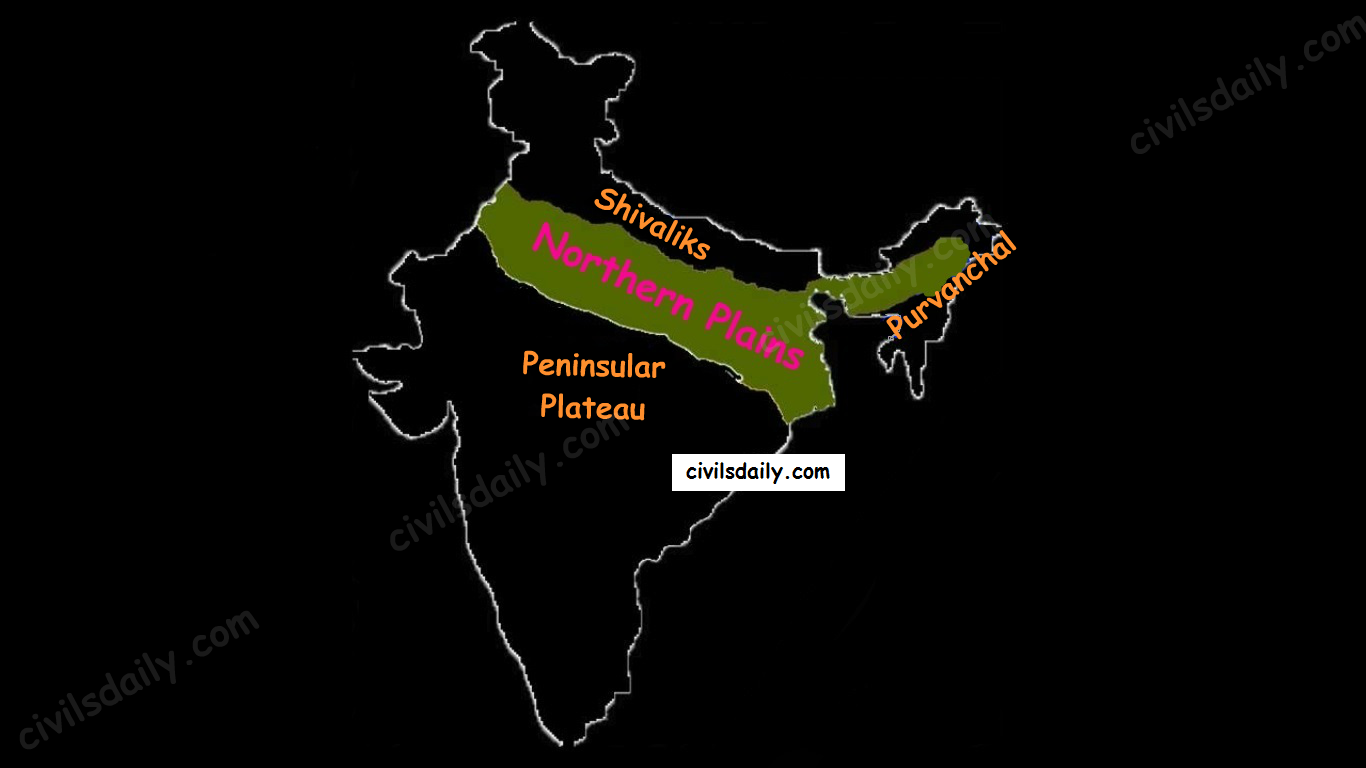
Formation of Northern Plains:
Due to the uplift of the Himalayas in the Tethys Sea, the northern part of the Indian Peninsula got subsided and formed a large basin.
Source
That basin was filled with sediments from the rivers which came from the mountains in the north and from the peninsula in the south. These extensive alluvial deposits led to the formation of the northern plains of India.
Chief Characteristics:
- The northern plain of India is formed by three river systems, i.e. the Indus, the Ganga and the Brahmaputra; along with their tributaries.
- The northern plains are the largest alluvial tract of the world. These plains extend approximately 3200 km from west to east.
- The average width of these plains varies between 150 and 300 km. In general, the width of the northern plains increases from east to west (90-100km in Assam to about 500km in Punjab).
- The exact depth of alluvium has not yet been fully determined. According to recent estimates, the average depth of alluvium in the southern side of the plain varies between 1300-1400m, while towards the Shiwaliks, the depth of alluvium increases. The maximum depth of over 8000m has been reached in parts of Haryana.
- The extreme horizontality of this monotonous plain is its chief characteristic (200m – 291m). The highest elevation of 291 m above mean sea level near Ambala forms a watershed between Indus system and Ganga system).
- The monotony of the physical landscape is broken at the micro level by the river bluffs, levees etc.
- [Floodplain – That part of a river valley, adjacent to the channel, over which a river flows in times of a flood.
- Levee – An elevated bank flanking the channel of the river and standing above the level of the flood plain.
- Bluff – A river cut cliff or steep slope on the outside of a meander. A line of bluffs often marks the edge of a former floodplain.]
Source
Physiographic Divisions of the Northern Plains:
From the north to the south, the northern plains can be divided into three major zones:
- The Bhabar
- The Tarai
- The alluvial plains.
The alluvial plains can be further divided into the Khadar and the Bhangar as illustrated below:
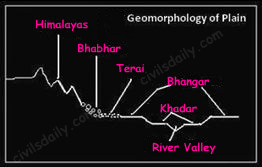
Let’s understand these divisions one by one:
Bhabar:
- Bhabar is a narrow belt (8-10km wide) which runs in the west-east direction along the foot of the Himalayas from the river Indus to Teesta.
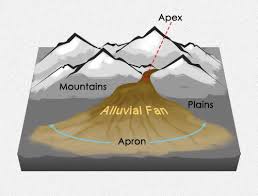
Source
- Rivers which descend from the Himalayas deposit their load along the foothills in the form of alluvial fans.
- These fans consisting of coarser sediments have merged together to build up the piedmont plain/the Bhabar.
- The porosity of the pebble-studded rock beds is very high and as a result, most of the streams sink and flow underground. Therefore, the area is characterized by dry river courses except in the rainy season.
- The Bhabar tract is not suitable for cultivation of crops. Only big trees with large roots thrive in this region.
- The Bhabar belt is comparatively narrow in the east and extensive in the western and north-western hilly region.
Tarai:
- It is a 10-20 km wide marshy region in the south of Bhabar and runs parallel to it.
- The Tarai is wider in the eastern parts of the Great Plains, especially in the Brahmaputra valley due to heavy rainfall.
- It is characterized by the re-emergence of the underground streams of the Bhabar belt.
- The reemerged water transforms large areas along the rivers into badly drained marshy lands.
- Once covered with dense forests, most of the Tarai land (especially in Punjab, Uttar Pradesh and Uttarakhand) has been reclaimed and turned into agricultural land over a period of time.
Bhangar:
- It is the older alluvium along the river beds forming terraces higher than the flood plain.
- Dark in colour, rich in humus content and productive.
- The soil is clayey in composition and has lime modules (called kankar)
- Found in doabs (inter-fluve areas)
- ‘The Barind plains’ in the deltaic region of Bengal and the ‘bhur formations’ in the middle Ganga and Yamuna doab are regional variations of Bhangar. [Bhur denotes an elevated piece of land situated along the banks of the Ganga river especially in the upper Ganga-Yamuna Doab. This has been formed due to accumulation of wind-blown sands during the hot dry months of the year]
- In relatively drier areas, the Bhangar also exhibits small tracts of saline and alkaline efflorescence known as ‘Reh’, ‘Kallar’ or ‘Bhur’. Reh areas have spread in recent times with increase in irrigation (capillary action brings salts to the surface).
- May have fossil remains of even those plants and animals which have become extinct.
Khadar:
- Composed of newer alluvium and forms the flood plains along the river banks.
- Light in colour, sandy in texture and more porous.
- Found near the riverbeds.
- A new layer of alluvium is deposited by river flood almost every year. This makes them the most fertile soils of Ganges.
- In Punjab, the Khadar rich flood plains are locally known as ‘Betlands’ or ‘Bets’.
- The rivers in Punjab-Haryana plains have broad flood plains of Khadar flanked by bluffs, locally known as Dhayas. These bluffs are as high as 3metres.
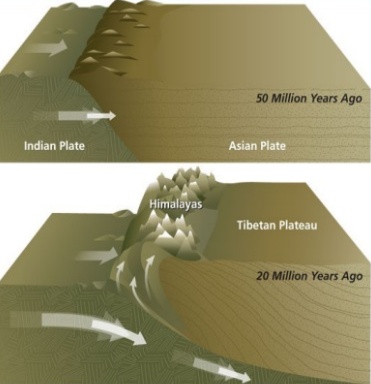
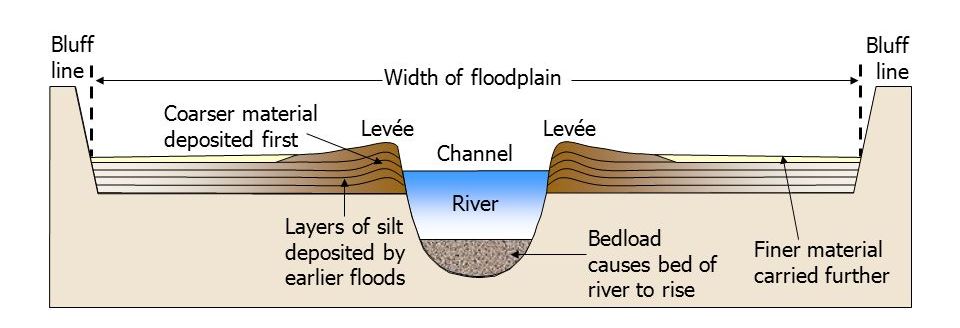


very nice info , thanks